Spatio-Temporal Variation of Elemental Contamination and Health of Mya arenaria Clam in the Saguenay–St. Lawrence Marine Park
Abstract
1. Introduction
2. Methods
2.1. Clam Collection and Handling
2.2. Tissue Metal Content Analysis
2.3. Morphological Biomarkers and Air Survival Test
2.4. Data Analysis
3. Results
4. Discussion
5. Conclusions
Author Contributions
Funding
Data Availability Statement
Acknowledgments
Conflicts of Interest
References
- Turgeon, S. Characterization of Navigation in the Saguenay–St. Lawrence Marine Park-2017; Parks Canada: Tadoussac, QC, Canada, 2019; 58p. [Google Scholar]
- Fortin, G.; Pelletier, M. Synthèse des Connaissances sur les Aspects Physiques et Chimiques de l’eau et des Sédiments du Saguenay: Zones d’Intervention Prioritaire 22 et 23; Technical Report; Environment Canada, Environmental Conservation, St. Lawrence Centre: Montréal, QC, Canada, 1995. [Google Scholar]
- Viglino, L.; Pelletier, É.; Lee, L.E.J. Butyltin Species in Benthic and Pelagic Organisms of the Saguenay Fjord (Canada) and Imposex Occurrence in Common Whelk (Buccinum undatum). Arch. Environ. Contam. Toxicol. 2005, 50, 45–59. [Google Scholar] [CrossRef]
- McKenzie, C.H.; Bates, S.S.; Martin, J.L.; Haigh, N.; Howland, K.L.; Lewis, N.I.; Locke, A.; Peña, A.; Poulin, M.; Rochon, A.; et al. Three decades of Canadian marine harmful algal events: Phytoplankton and phycotoxins of concern to human and ecosystem health. Harmful Algae 2021, 102, 101852. [Google Scholar] [CrossRef]
- Yang, R.; Zhou, Q.; Jiang, G. Butyltin accumulation in the marine clam Mya arenaria: Anevaluation of its suitability for monitoring butyltin pollution. Chemosphere 2006, 63, 1–8. [Google Scholar] [CrossRef]
- Gagnon, F.; Tremblay, T.; Rouette, J.; Cartier, J.-F. Chemical risks associated with consumption of shellfish harvested on the north shore of the St. Lawrence River’s lower estuary. Environ. Health Perspect. 2004, 112, 883–888. [Google Scholar] [CrossRef] [PubMed]
- Blaise, C.; Gagne, F.; Gillis, P.L.; Eullaffroy, P. Polychaetes as Bioindicators of Water Quality in the Saguenay Fjord (Quebec, Canada): A Preliminary Investigation. J. Xenobiotics 2013, 3, 1–2. [Google Scholar] [CrossRef][Green Version]
- Pellerin, J.; Fournier, M.; Gauthier-Clerc, S.; Blaise, C.; Florent, G.; Amiard, J.-C.; Gagné, F. How is the health status of Mya arenaria in the Saguenay fjord? A statement from a 14-year survey. Revue Sci. de l’Eau 2009, 22, 271–289. [Google Scholar] [CrossRef][Green Version]
- Gagné, F.; Blaise, C.; Pellerin, J.; Fournier, M. Biomarker studies of the soft-shell clam (Mya arenaria) in the Saguenay Fjord: Research results (1997–2006). Revue Sci. de l’Eau 2009, 22, 253–259. [Google Scholar] [CrossRef][Green Version]
- Blaise, C.; Gagné, F.; Burgeot, T. Three simple biomarkers useful in conducting water quality assessments with bivalve mollusks. Environ. Sci. Pollut. Res. 2016, 24, 27662–27669. [Google Scholar] [CrossRef] [PubMed]
- Eertman, R.H.M.; Wagenvoort, A.J.; Hummel, H.; Smaal, A.C. Survival in air of the blue mussel Mytilus edulis L. as a sensitive response to pollution-induced environments stress. J. Exp. Mar. Biol. Ecol. 1993, 170, 179–195. [Google Scholar] [CrossRef]
- André, C.; Bibeault, J.F.; Gagné, F. Identifying physiological traits of species resilience against environmental stress in freshwater mussels. Ecotoxicology 2021, 30, 1862–1871. [Google Scholar] [CrossRef]
- Lefebvre, S.L.; Michaud, R.; Lesage, V.; Berteaux, D. Identifying high residency areas of the threatened St. Lawrence beluga whale from fine-scale movements of individuals and coarse-scale movements of herds. Mar. Ecol. Prog. Ser. 2012, 450, 243–257. [Google Scholar] [CrossRef]
- Ménard, N.; Conversano, M.; Turgeon, S. La protection des habitats de la population de bélugas (Delphinapterus leucas) du Saint-Laurent: Bilan et considérations sur les besoins de conservation. Le Nat. Can. 2018, 142, 80–105. [Google Scholar] [CrossRef][Green Version]
- Environment and Climate Change Canada. Standard Operating Procedure for the Analysis of Total Metals in Wet and Dry Biota and Flora by Microwave Assisted Acid Digestion and Inductively Coupled Plasma Quadrupole Mass Spectrometry with Collision/Reaction Cell Capability (CRC-ICP-QMS); Government Report, NELAC Method 02-2704, Version 1.2; Environment and Climate Change Canada: Gatineau, QC, Canada, 2019; 25p. [Google Scholar]
- Moorthy, K.; Reddy, B.; Swami, K.; Chetty, C. Changes in respiration and ionic content in tissues of freshwater mussel exposed to methyl parathion toxicity. Toxicol. Lett. 1984, 21, 287–291. [Google Scholar] [CrossRef]
- Sivaramakrishna, B.; Radhakrishnaiah, K.; Suresh, A. Environmental Contamination ~and Toxicology Assessment of Mercury Toxicity by the Changes in Oxygen Consumption and Ion Levels in the Freshwater Snail, Pila globosa, and the Mussel, Lamellidens marginalis. Bull. Environ. Contam. Toxicol. 1991, 46, 913–920. [Google Scholar] [CrossRef]
- Maetz, J. Transport of Ions and Water Across the Epithelium of Fish Gills. Novartis Found. Symp. 1976, 38, 133–159. [Google Scholar] [CrossRef]
- Corbin, J.C.; Mensah, A.A.; Pieber, S.M.; Orasche, J.; Michalke, B.; Zanatta, M.; Czech, H.; Massabò, D.; de Mongeot, F.B.; Mennucci, C.; et al. Trace Metals in Soot and PM 2.5 from Heavy-Fuel-Oil Combustion in a Marine Engine. Environ. Sci. Technol. 2018, 52, 6714–6722. [Google Scholar] [CrossRef]
- Amiard, J.-C.; Journel, R.; Bacheley, H. Influence of field and experimental exposure of mussels (Mytilus sp.) to nickel and vanadium on metallothionein concentration. Comp. Biochem. Physiol. Part C Toxicol. Pharmacol. 2008, 147, 378–385. [Google Scholar] [CrossRef] [PubMed]
- Gagné, F.; Blaise, C.; Pellerin, J.; Pelletier, E.; Strand, J. Health status of Mya arenaria bivalves collected from contaminated sites in Canada (Saguenay Fjord) and Denmark (Odense Fjord) during their reproductive period. Ecotoxicol. Environ. Saf. 2006, 64, 348–361. [Google Scholar] [CrossRef]
- Zhan, J.; Wang, S.; Li, F.; Ji, C.; Wu, H. Dose-dependent responses of metabolism and tissue injuries in clam Ruditapes philippinarum after subchronic exposure to cadmium. Sci. Total Environ. 2021, 779, 146479. [Google Scholar] [CrossRef]
- Barceloux, D.G. Manganese. J. Clin. Toxicol. 1999, 37, 293–307. [Google Scholar] [CrossRef]
- Herrmann, H.; Nolde, J.; Berger, S.; Heise, S. Aquatic ecotoxicity of lanthanum—A review and an attempt to derive water and sediment quality criteria. Ecotoxicol. Environ. Saf. 2016, 124, 213–238. [Google Scholar] [CrossRef]
- Lynam, D.R.; Roos, J.W.; Pfeifer, G.D.; Fort, B.F.; Pullin, T.G. Environmental effects and exposures to manganese from use of methylcyclopentadienyl manganese tricarbonyl (MMT) in gasoline. NeuroToxicology 1999, 20, 145–150. [Google Scholar]
- Fernandes de Oliveira, L.; Cabral, M.T.; Risso, W.E.; Martinez, C.B.D.R. Single and combined effects of Zn, Mn and Fe on the Neotropical freshwater bivalve Anodontites trapesialis: Bioaccumulation and biochemical biomarkers. Ecotoxicol. Environ. Saf. 2018, 161, 735–745. [Google Scholar] [CrossRef]
- Fernandes de Oliveira, L.; Cabral, M.T.; Nascimento, C.B.; Magni, S.; Binelli, A.; Martinez, C.B.D.R. Single and combined effects of zinc and manganese on the bivalve Anodontites trapesialis: Complementary Endpoints to Support the Hypothesis of Manganese Promoting Metabolic Suppression in Gills. Environ. Toxicol. Chem. 2019, 38, 2480–2485. [Google Scholar] [CrossRef] [PubMed]
- Purcell, T.W.; Peters, J.J. Sources of silver in the environment. Environ. Toxicol. Chem. 1998, 17, 539–546. [Google Scholar] [CrossRef]
- Nobles, T.; Zhang, Y. Survival, Growth and Condition of Freshwater Mussels: Effects of Municipal Wastewater Effluent. PLoS ONE 2015, 10, e0128488. [Google Scholar]
- Angelo, R.T.; Cringan, M.S.; Chamberlain, D.L.; Stahl, A.J.; Haslouer, S.G.; Goodrich, C.A. Residual effects of lead and zinc mining on freshwater mussels in the Spring River Basin (Kansas, Missouri, and Oklahoma, USA). Sci. Total Environ. 2007, 384, 467–496. [Google Scholar] [CrossRef]
- Becker, P.R.; Krahn, M.M.; Mackey, E.A.; Demiralp, R.; Schantz, M.M.; Epstein, M.S.; Donais, M.K.; Porter, B.J.; Muir, D.C.G.; Wise, S.A. Chlorinated pesticides, and heavy metals and other elements in tissues of Belugas, Delphinapterus leucas, from ook Inlet, Alaska. Mar. Fishe. Rev. 2000, 62, 81–98. [Google Scholar]
- Loseto, L.L.; Stern, G.A.; Macdonald, R.W. Distant drivers or local signals: Where do mercury trends in western Arctic belugas originate? Sci. Total Environ. 2015, 509–510, 226–236. [Google Scholar] [CrossRef]
- Hamer, B.; Jaksić, Z.; Pavicić-Hamer, D.; Perić, L.; Medaković, D.; Ivanković, D.; Pavicić, J.; Zilberberg, C.; Schröde, H.C.; Müller, W.E.G.; et al. Effect of hypoosmotic stress by low salinity acclimation of Mediterranean mussels Mytilus galloprovincialis on biological parameters used for pollution assessment. Aquat. Toxicol. 2008, 89, 137–151. [Google Scholar] [CrossRef]
- Isaza, D.F.G.; Cramp, R.L.; Franklin, C.E. Living in polluted waters: A meta-analysis of the effects of nitrate and interactions with other environmental stressors on freshwater taxa. Environ. Pollut. 2020, 261, 114091. [Google Scholar] [CrossRef] [PubMed]
- Fitzgerald, A.M.; Wallace, W.G.; Zarnoch, C.B. Spatial and temporal trends in physiological biomarkers of adult eastern oysters, Crassostrea virginica, within an urban estuary. Mar. Environ. Res. 2020, 161, 105122. [Google Scholar] [CrossRef] [PubMed]
- Gagné, F.; Blaise, C.; Pellerin, J.; Pelletier, E.; Douville, M.; Gauthier-Clerc, S.; Viglino, L. Sex alteration in soft-shell clams (Mya arenaria) in an intertidal zone of the Saint Lawrence river (Quebec, Canada). Comp. Biochem. Physiol. Part C Toxicol. Pharmacol. 2003, 134, 189–198. [Google Scholar] [CrossRef]

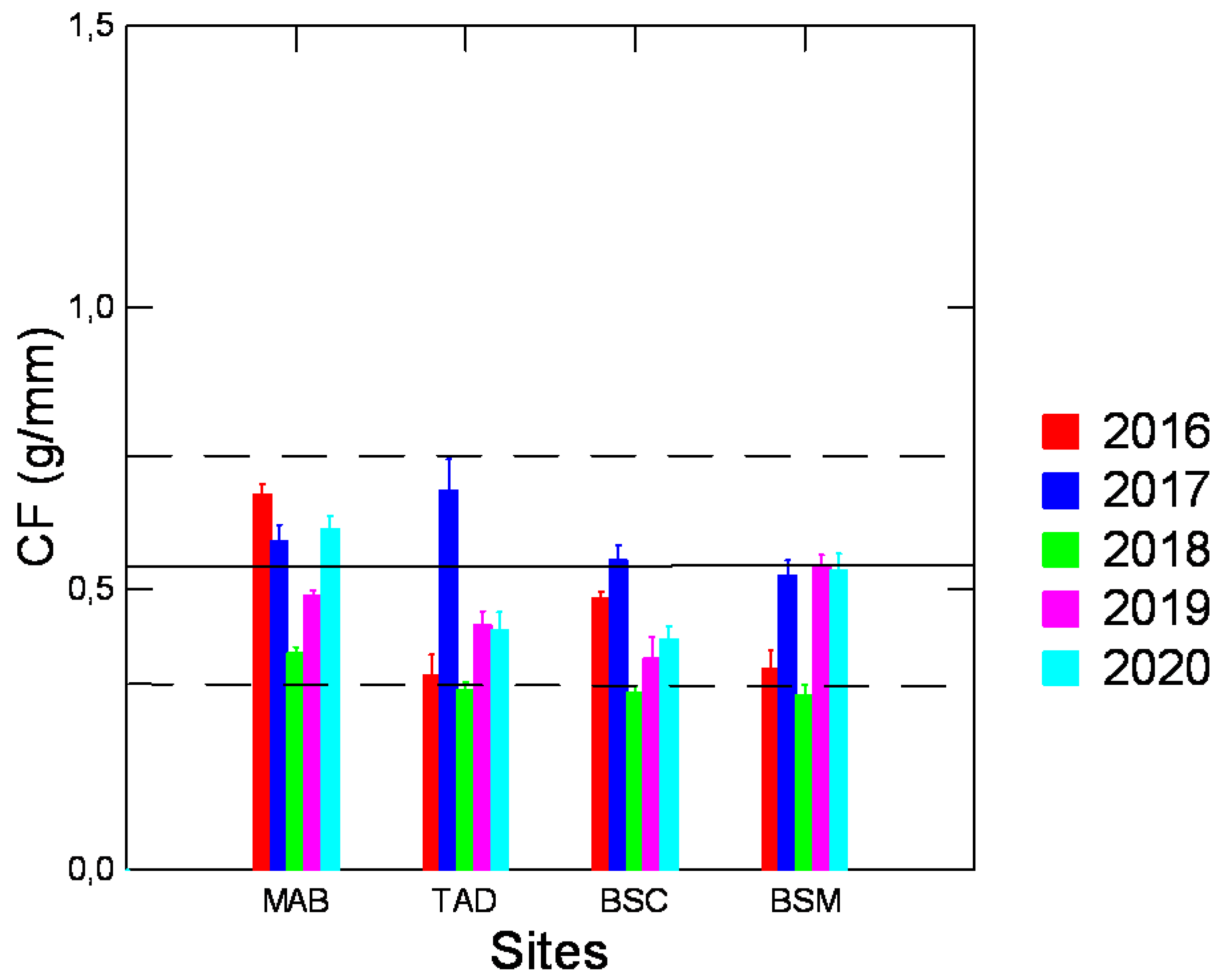
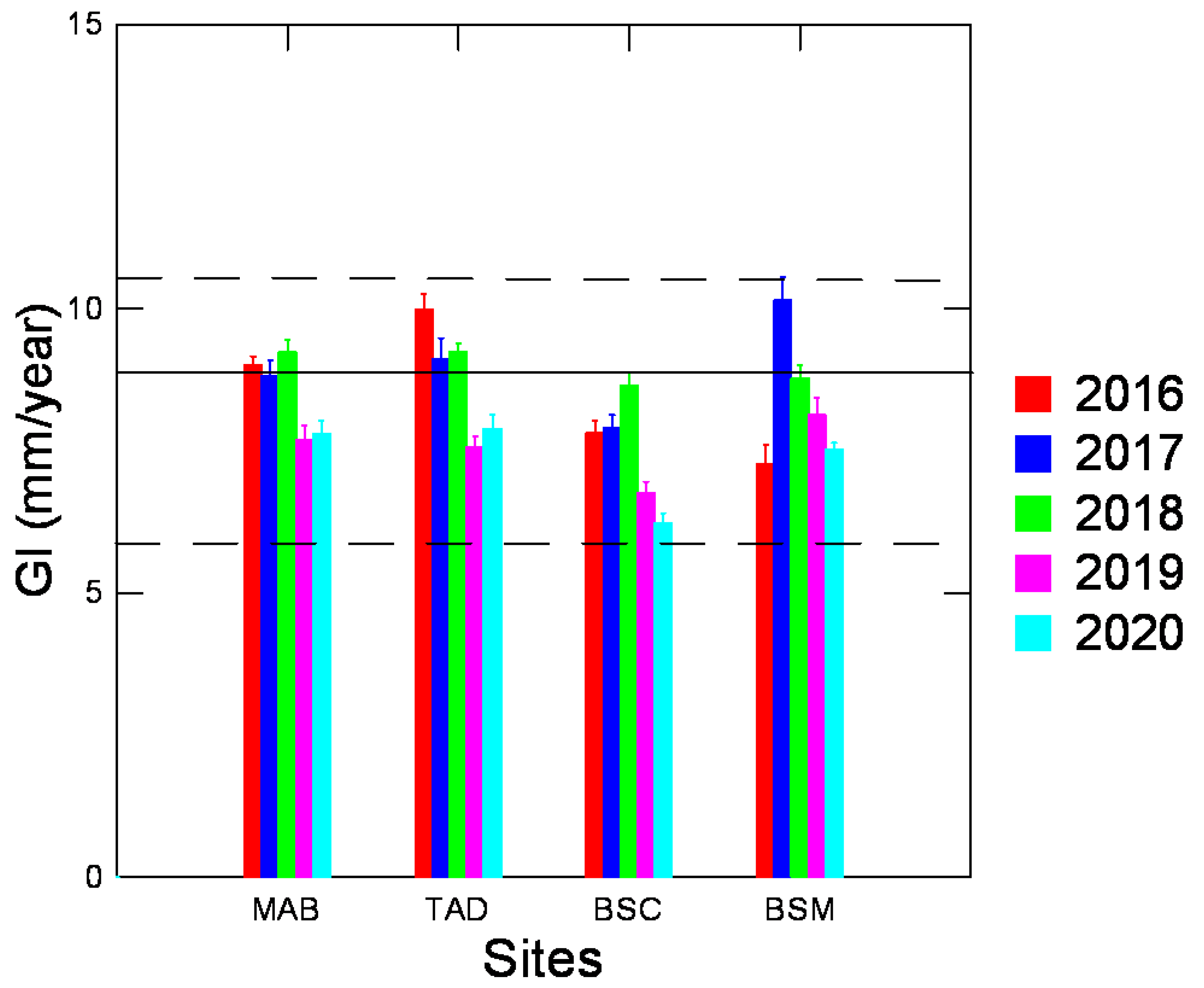
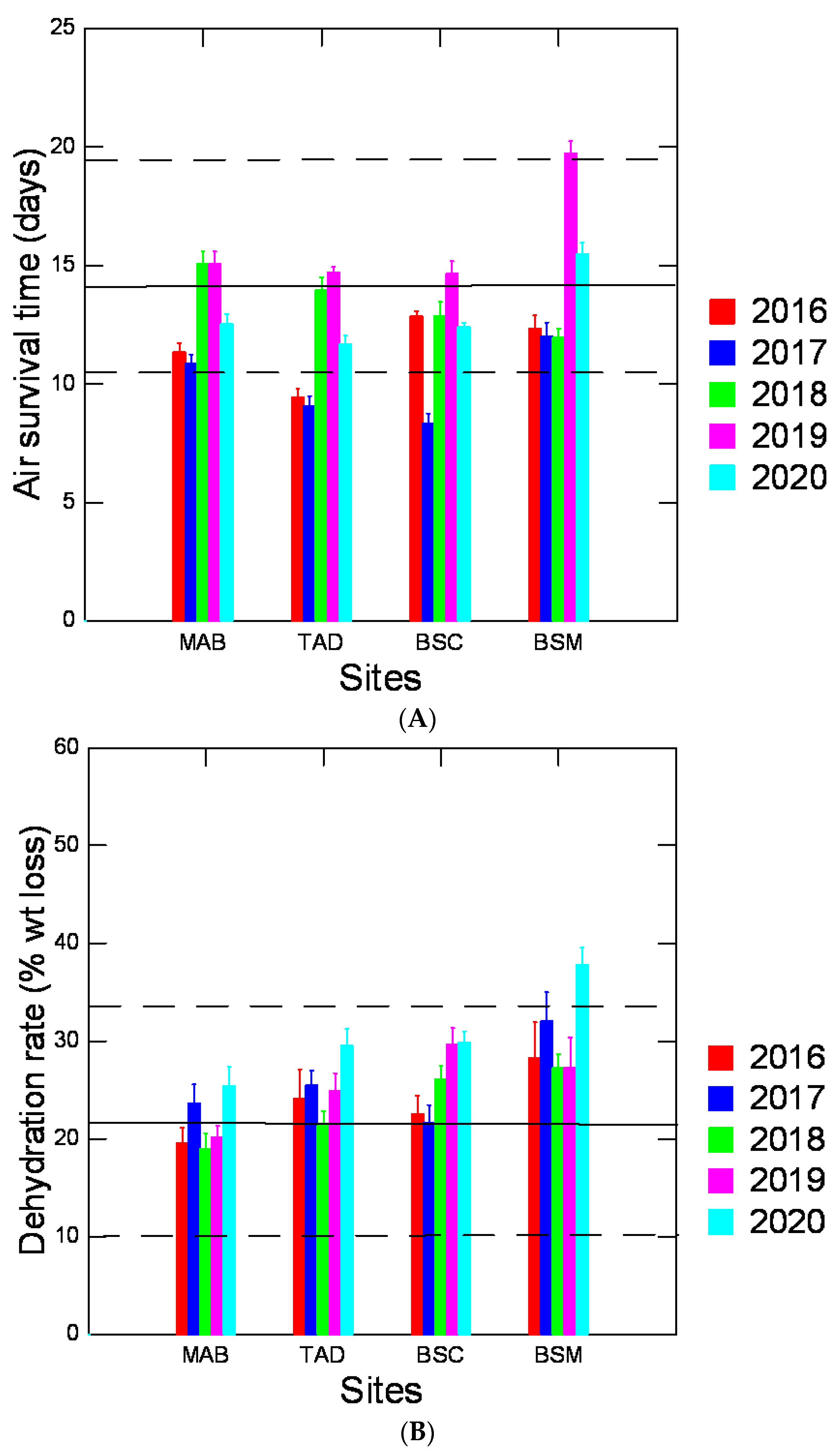
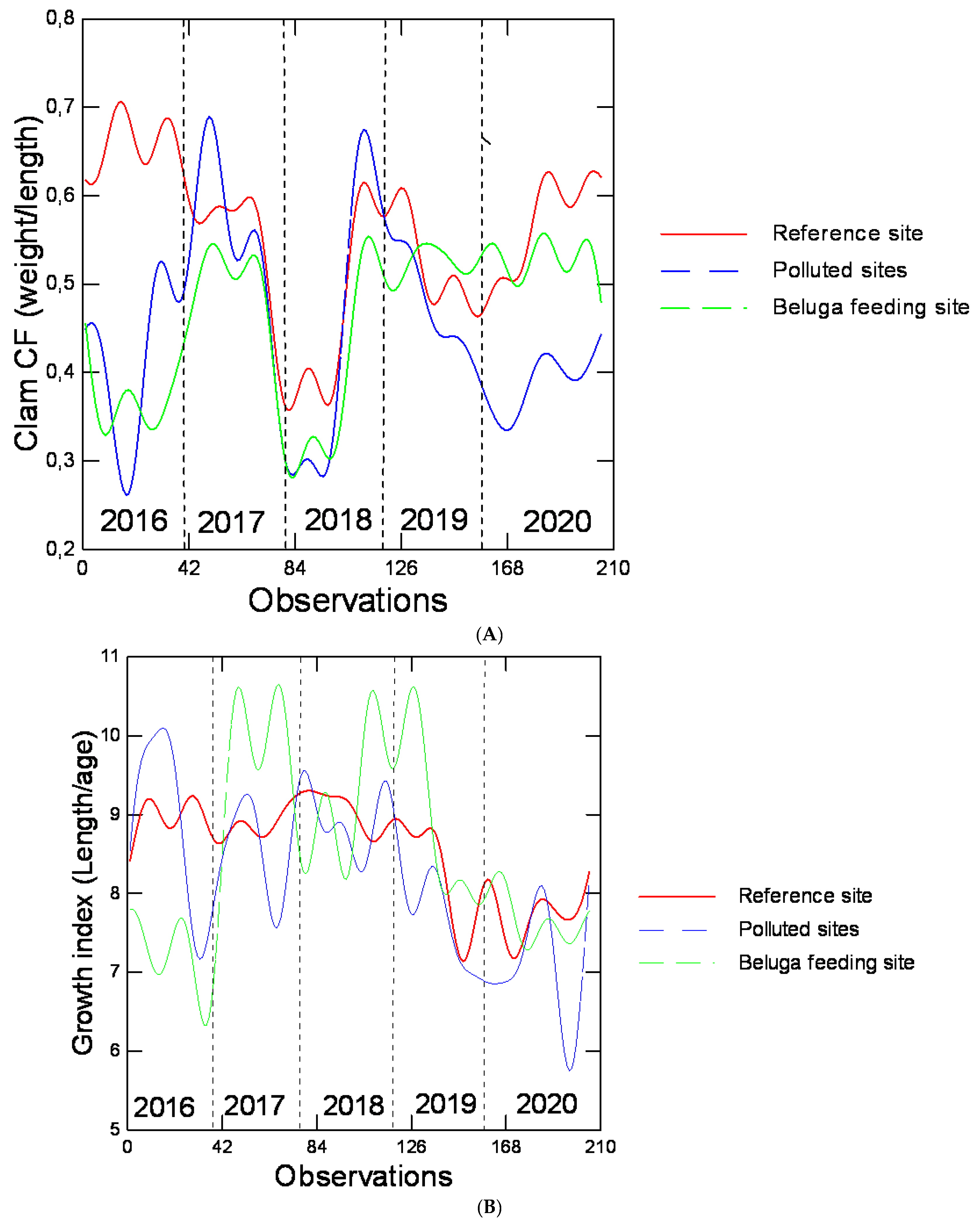
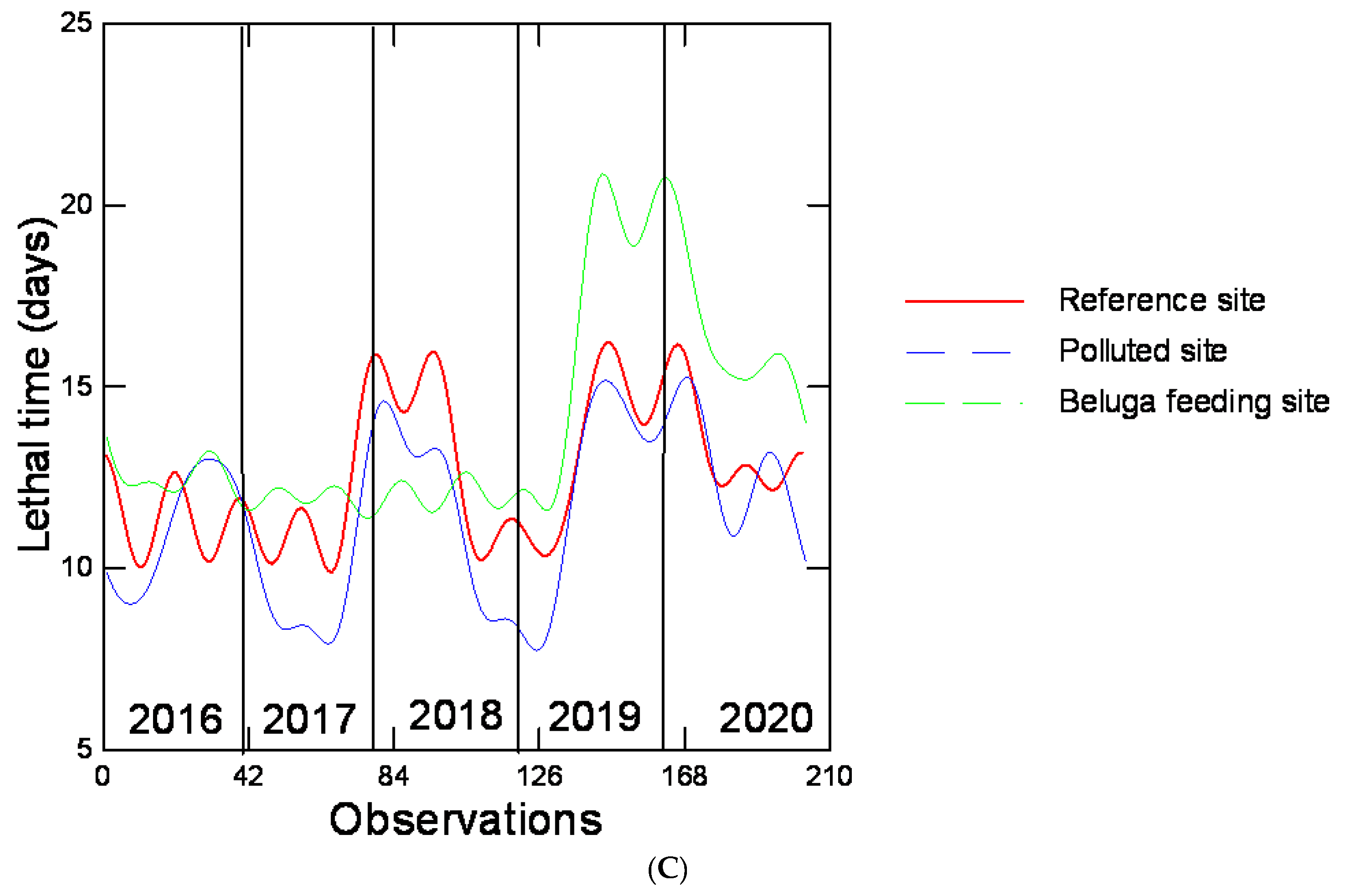
| Response Range | Natural Mean (5–95th) | Polluted | BSM (SLE Beluga Area of High Residency) | Threshold Concentration |
|---|---|---|---|---|
| Elements 1 | ||||
| Ag | 0.08 (0.04–0.11) | 0.18 (0.05–0.5) 1 | 0.21 (0.06–0.7) 1 | 0.12 |
| Al | 75 (22–123) | 82 (25–171) | 127 (65–251) 2 | 102 |
| Ba | 0.6 (0.3–1) | 0.64 (0.3–1.2) | 1 (0.57–2) 2 | 0.77 |
| Be | 0.007 (0.001–0.01) | 0.007 (0.001–0.01) | 0.01 (0.004–0.02) 2 | 0.008 |
| Cd | 0.067 (0.04–0.085) | 0.08 (0.05–0.11) 1 | 0.1 (0.077–0.14) 2 | 0.08 |
| Ce | 0.69 (0.12–1.29) | 0.87 (0.25–2) | 1.7 (1–3.1) 2 | 1.08 |
| Co | 0.15 (0.05–0.26) | 0.2 (0.05–0.5) | 0.3 (0.2–0.6) 2 | 0.07 |
| Cr | 4 (0.23–8.2) | 6.3 (0.4–20) 1 | 6.7 (2–14) 1 | 5 |
| Ca | 459 (356–620) | 535 (344–973) 1 | 461 (378–580) | 495 |
| Gd | 0.05 (0.02–0.08) | 0.05 (0.02–0.14) | 0.09 (0.06–0.19) 2 | 0.07 |
| Ga | 0.04 (0.01–0.09) | 0.04 (0.01–0.14) | 0.08 (0.04–0.19) 2 | 0.06 |
| Cu | 1.8 (1.2–2.7) | 1.9 (1–3) | 2.3 (1.5–3.2) 2 | 2 |
| Fe | 214 (45–511) | 234 (52–754) | 357 (134–800) 20.67 | 276 |
| La | 0.4 (0.1–0.8) | 0.55 (0.1–1.1) | 1.1 (0.4–2) 2 | 0.7 |
| Pb | 0.06 (0.02–0.14) | 0.07 (0.02–0.14) | 0.1 (0.05–0.24) 2 | 0.08 |
| Mg | 681 (475–830) | 655 (460–834) | 500 (342–688) 2 | 583 |
| Mn | 2.4 (0.6–4.4) | 6 (1.1–44) 1 | 6.6 (2.2–17)1 | 3.8 |
| Mo | 0.59 (0.16–0.98) | 0.95 (0.14–2.6) 1 | 0.78 (0.28–1.9) | 0.75 |
| Hg | 0.02 (0.008–0.04) | 0.02 (0.007–0.04) | 0.05 (0.03–0.08) 2 | 0.03 |
| Nd | 0.47 (0.11–0.97) | 0.78 (0.14–2.6) 1 | 0.96 (0.4–3.1) 1 | 0.67 |
| Ni | 0.33 (0.12–0.54) | 0.39 (0.14–0.9) | 0.73 (0.46–1.37) 1 | 0.49 |
| Nb | 2.5 (0.19–5.3) | 4 (0.3–12.4) 1 | 4.3 (1.3–8.9) 1 | 3 |
| P | 0.02 (0.008–0.04) | 0.02 (0.009–0.04) | 0.03 (0.01–0.06) 1 | 0.025 |
| K | 1050 (821–1384) | 978 (796–1310) 1 | 937 (820–1051) 1 | 1013 |
| Sm | 0.1 (0.03–0.19) | 0.12 (0.02–0.24) 1 | 0.2 (0.15–0.34) 2 | 0.11 |
| Sn | 0.03 (0.009–0.05) | 0.04 (0.008–0.07) | 0.05 (0.02–0.09) 2 | 0.04 |
| U | 0.03 (0.01–0.03) | 0.03 (0.01–0.05) | 0.04 (0.02–0.07) 2 | 0.04 |
| V | 0.04 (0.02–0.12) | 0.25 (0.02–0.8) 1 | 0.8 (0.05–1.4) 2 | 0.1 |
| Y | 0.03 (0.004–0.05) | 0.03 (0.005–0.05) | 0.04 (0.01–0.06) 2 | 0.035 |
| Zn | 0.16 (0.07–0.3) | 0.2 (0.07–0.51) | 0.3 (0.2–0.65) 2 | 0.22 |
| Zr | 12.8 (9.9–17.1) | 13 (9.7–16.6) | 17 (10.8–25.5) 2 | 15 |
| Response Range | Length (mm) | Mass (g) | Age | CF | GI | Air Survival Time (Days) | Maximal Dehydration (%) |
|---|---|---|---|---|---|---|---|
| Natural | |||||||
| Mean | 61.7 | 32.6 | 7.2 | 0.52 | 8.5 | 13.2 | 20.7 |
| Percentiles | |||||||
| 25–75th | 56–66 | 23.1–41 | 6.3–8 | 0.4–0.62 | 8.2–9.5 | 11–14 | 16–24 |
| 5–95th | 42–72 | 19.4–52.1 | 5.8–9 | 0.36–0.73 | 6.8–10.6 | 10–19 | 9.8–34 |
| Impacted (BSC and TAD) | |||||||
| Mean | 59.3 * | 26.6 * | 7.2 | 0.43 * | 8.2 * | 12 * | 24.5 * |
| Percentiles | |||||||
| 25–75th | 54–63 | 16.1–31.6 | 6.1–8 | 0.3–0.52 | 7.5–9.1 | 10–13.6 | 19–29 |
| 5–95th | 49–78 | 12.3–57.1 | 5.4–10 | 0.26–0.73 | 6.3–9.1 | 7–16 | 11–34 |
| BSM (SLE Beluga area of high residency) | |||||||
| Mean | 62.4 | 28 * | 7.3 | 0.43 * | 8.6 | 13.6 | 29.9 * |
| Percentiles | |||||||
| 25–75th | 57.4–68.6 | 17.8–36.8 | 6.3–8 | 0.3–0.54 | 7.5–9.3 | 10.9–14 | 24–36 |
| 5–95th | 46–75 | 11.9–47.9 | 5.7–10 | 0.24–0.54 | 6.5–11.8 | 8–21 | 13–48 |
| LT | WL | Ag | CF | GI | Ca | Ce | Gd | Ga | Fe | La | Mn | |
|---|---|---|---|---|---|---|---|---|---|---|---|---|
| LT | 1 | |||||||||||
| WL | −0.15 | 1 | ||||||||||
| Age | −0.49 | 0.25 | 1 | |||||||||
| CF | −0.34 | −0.01 | 0.6 | 1 | ||||||||
| GI | 0.31 | −0.19 | −0.72 | −0.04 | 1 | |||||||
| Ca | 0.31 | −0.17 | −0.29 | −0.33 | 0.13 | 1 | ||||||
| Ce | 0.14 | 0.43 | 0.01 | −0.22 | −0.01 | 0.22 | 1 | |||||
| Gd | 0.48 | 0.22 | −0.3 | −0.4 | 0.22 | 0.47 | 0.85 | 1 | ||||
| Ga | 0.39 | 0.16 | −0.29 | −0.31 | 0.26 | 0.45 | 0.79 | 0.91 | 1 | |||
| Fe | 0.52 | −0.03 | −0.43 | −0.39 | 0.31 | 0.57 | 0.5 | 0.79 | 0.9 | 1 | ||
| La | 0.12 | 0.47 | −0.01 | −0.18 | 0.04 | 0.09 | 0.95 | 0.76 | 0.68 | 0.34 | 1 | |
| Mn | 0.34 | 0.02 | −0.33 | −0.3 | 0.29 | 0.56 | 0.38 | 0.53 | 0.53 | 0.53 | 0.34 | 1 |
| K | 0.15 | −0.32 | −0.16 | −0.13 | 0.04 | 0.27 | −0.17 | −0.01 | 0.04 | 0.25 | −0.31 | 0.21 |
| Sm | 0.32 | 0.37 | −0.16 | −0.29 | 0.15 | 0.24 | 0.92 | 0.89 | 0.75 | 0.49 | 0.95 | 0.45 |
| Ag | −0.11 | 0.48 | 0.21 | −0.25 | −0.37 | 0.06 | 0.37 | 0.28 | 0.09 | 0.02 | 0.36 | 0.06 |
| V | −0.4 | 0.16 | 0.29 | 0.29 | −0.04 | 0.08 | 0.56 | 0.32 | 0.38 | 0.11 | 0.54 | 0.17 |
| Ni | 0.19 | 0.41 | −0.06 | −0.22 | 0.09 | 0.28 | 0.97 | 0.88 | 0.88 | 0.63 | 0.92 | 0.43 |
| Nd | 0.23 | 0.09 | −0.23 | −0.33 | 0.16 | 0.71 | 0.45 | 0.54 | 0.63 | 0.64 | 0.3 | 0.71 |
| Mo | −0.44 | 0.14 | 0.43 | 0.37 | −0.19 | −0.27 | 0.03 | −0.13 | −0.06 | −0.16 | 0 | −0.14 |
| Pb | −0.02 | 0.21 | 0.03 | −0.02 | 0.04 | 0.45 | 0.49 | 0.43 | 0.48 | 0.38 | 0.39 | 0.44 |
| Cd | 0.11 | 0.42 | 0.01 | −0.2 | 0.01 | 0.33 | 0.72 | 0.62 | 0.42 | 0.23 | 0.71 | 0.48 |
| Mg | 0.03 | −0.36 | −0.11 | 0.06 | 0.02 | 0.05 | −0.59 | −0.51 | −0.38 | −0.17 | −0.6 | −0.25 |
| Nb | 0.37 | −0.08 | −0.35 | −0.41 | 0.22 | 0.77 | 0.26 | 0.49 | 0.42 | 0.51 | 0.15 | 0.74 |
| Cr | 0.39 | −0.09 | −0.34 | −0.42 | 0.18 | 0.78 | 0.25 | 0.5 | 0.43 | 0.53 | 0.12 | 0.76 |
| Hg | 0.11 | 0.5 | 0.03 | −0.12 | 0.03 | −0.01 | 0.88 | 0.74 | 0.59 | 0.25 | 0.97 | 0.45 |
| Sm | −0.22 | 1 | ||||||||||
| Ag | −0.01 | 0.36 | 1 | |||||||||
| V | −0.1 | 0.43 | 0.13 | 1 | ||||||||
| Ni | −0.16 | 0.9 | 0.29 | 0.54 | 1 | |||||||
| Nd | 0.26 | 0.36 | 0.11 | 0.18 | 0.54 | 1 | ||||||
| Mo | 0.01 | −0.11 | 0.05 | 0.47 | 0.04 | −0.07 | 1 | |||||
| Pb | 0.17 | 0.38 | 0.02 | 0.53 | 0.52 | 0.61 | 0.31 | 1 | ||||
| Cd | 0.04 | 0.73 | 0.45 | 0.35 | 0.65 | 0.5 | 0.1 | 0.53 | 1 | |||
| Mg | −0.04 | −0.6 | −0.37 | −0.48 | −0.56 | −0.21 | −0.58 | −0.53 | −0.69 | 1 | ||
| Nb | 0.31 | 0.32 | 0.13 | 0.02 | 0.3 | 0.87 | −0.17 | 0.47 | 0.52 | −0.19 | 1 | |
| Cr | 0.32 | 0.31 | 0.13 | 0.02 | 0.3 | 0.88 | −0.18 | 0.45 | 0.54 | −0.21 | 0.9 | 1 |
| Hg | −0.38 | 0.94 | 0.35 | 0.54 | 0.84 | 0.21 | −0.01 | 0.33 | 0.71 | −0.61 | 0.12 | 0.11 |
Publisher’s Note: MDPI stays neutral with regard to jurisdictional claims in published maps and institutional affiliations. |
© 2022 by the authors. Licensee MDPI, Basel, Switzerland. This article is an open access article distributed under the terms and conditions of the Creative Commons Attribution (CC BY) license (https://creativecommons.org/licenses/by/4.0/).
Share and Cite
Gagné, F.; André, C.; Turgeon, S.; Ménard, N. Spatio-Temporal Variation of Elemental Contamination and Health of Mya arenaria Clam in the Saguenay–St. Lawrence Marine Park. Appl. Sci. 2022, 12, 1106. https://doi.org/10.3390/app12031106
Gagné F, André C, Turgeon S, Ménard N. Spatio-Temporal Variation of Elemental Contamination and Health of Mya arenaria Clam in the Saguenay–St. Lawrence Marine Park. Applied Sciences. 2022; 12(3):1106. https://doi.org/10.3390/app12031106
Chicago/Turabian StyleGagné, François, Chantale André, Samuel Turgeon, and Nadia Ménard. 2022. "Spatio-Temporal Variation of Elemental Contamination and Health of Mya arenaria Clam in the Saguenay–St. Lawrence Marine Park" Applied Sciences 12, no. 3: 1106. https://doi.org/10.3390/app12031106
APA StyleGagné, F., André, C., Turgeon, S., & Ménard, N. (2022). Spatio-Temporal Variation of Elemental Contamination and Health of Mya arenaria Clam in the Saguenay–St. Lawrence Marine Park. Applied Sciences, 12(3), 1106. https://doi.org/10.3390/app12031106






